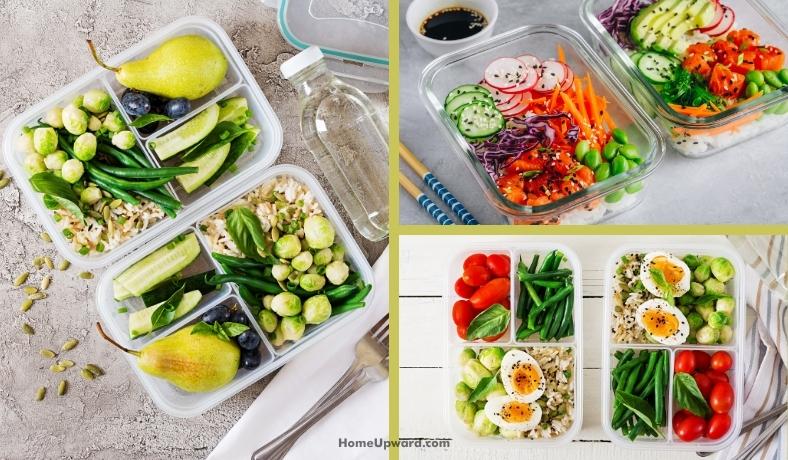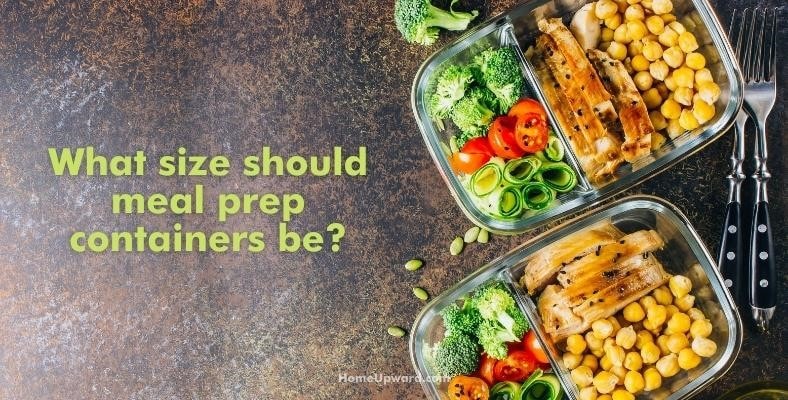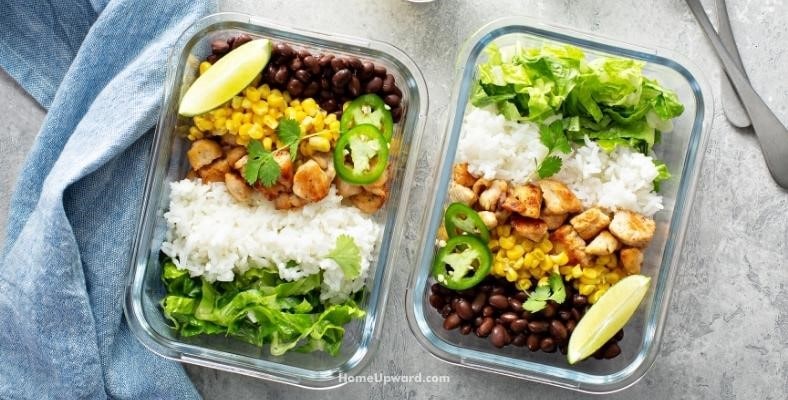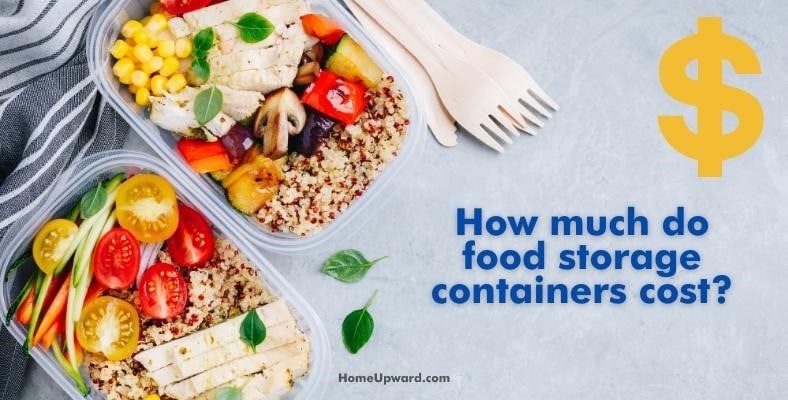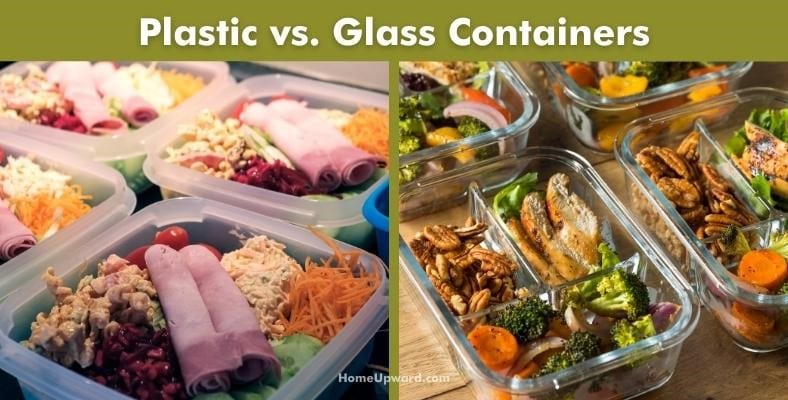Contents
What Size Should Meal Prep Containers Be?
You can’t rely on “one size fits all” containers when you have specific foods to consider, so running a little research on the best meal prep container sizes matters.
Food Capacity
With sizes ranging from one cup to seven cups and more, choosing the right ones for you can be daunting. However, if you’re all for experimenting, try buying cheap food containers temporarily and see what size works the best for your food options.
For instance:
- If you’re a fan of big salads you might want to go for a 7-cup circular box with lots of space to store and mix your salads.
- If most of your meals are standard size you can go for the 3-cup (29oz) boxes.
You can find some excellent deals at the local dollar store or discount store so you can figure the sizes out before investing money in buying multiple meal prep containers.
Why Are Good Storage Containers Important for Meal Planning?
A fast-paced lifestyle demands quick and efficient hacks for everything. The same holds true for planning your meals. A suitable meal prep container can make your life easy in many ways.
- A suitable meal prep container keeps your food organized so when the hunger hour strikes you can just pull out the prep container, heat the food if necessary, and enjoy a ready-made meal.
- Good storage containers also make meal prep work easier and simple.
- Proper containers keep your food fresh throughout the week. The goal of meal planning is to save time, but it’s also to stay healthy. You don’t want to be treated with stale or spoiled food at the end of a busy day.
- Quality storage containers also make sure there are no spilling nightmares with your food.
- They’re easy to use and easy to wash and store.
These quick solutions, especially with something as important as daily meals, cancel out all your food-related stress.
What Features Do You Need in Food Prep Containers?
You don’t want a prep container that might leak or turn your crisp food into soggy nightmares. However, with so many materials and sizes doing the rounds of the market, I can understand how it can be a headache trying to figure out what you need!
Recommended Things to Look For
Before you start your meal prep container shopping spree, here’s a quick checklist to help you make an informed choice.
1. Airtight seal
The king of all considerations – making sure the container is airtight serves two purposes: it stops other smells in the fridge from seeping inside and keeps the food fresh for a long time.
2. Leak-Free
You don’t want liquid foods like salad dressings to leak out of the food container and create unnecessary messes. However, since liquids are essential parts of most foods, you might want to make sure your container is leak-proof through and through.
3. Clear or See-Through
Transparent material has a simple role to play. It lets you check on the contents inside without opening the box. That way, your food lasts longer.
4. BPA Free Plastic
When dealing with plastic, you want to make sure it’s BPA-free. Bisphenol A or BPA includes polycarbonate, which can be carcinogenic. When buying meal prep containers (plastic or glass), hunt for the label that says “BPA-free.”
5. Microwave Oven Safe
You might have to heat certain prepped foods. The whole idea of meal prep is to save time. So it only makes sense to go for the microwave or oven-safe one.
6. Dishwasher Safe
Again, for time-saving purposes, go for containers that you can toss in a dishwasher.
7. Freezer Safe
Most containers work perfectly for a freezer meal. That said, there’s no harm in double-checking.
8. Stackable and Easy to Store
Appropriate containers don’t usually create a fuss when it comes to storage. Stacking them all in one place is a plus for ease of use.
I like containers that stack easily because I can also fit more in my freezer and refrigerator, especially in the limited space between shelves. Space savings is important when you’re cooking for a whole week!
9. Food Dividers
Why deal with the headaches of multiple boxes when you can place all your food in one place? This is where food dividers or a compartment container work wonders.
I love built-in food dividers in storage containers because they keep sauce, dressing, or oils out of nearby food which won’t taste right when mixed with it.
Also, they help keep everything in place so my food doesn’t shift around and become a mess while traveling with it to work or on a trip.
Should You Put Meal Prep Containers in the Dishwasher or Hand Wash?
When it comes to the best way to clean your containers the most honest answer is that it depends.
- For glass containers, see if the product features include dishwasher safe. In case it doesn’t, go for handwashing it.
- While most plastic containers are dishwasher safe, it’s usually good to wash them by hand because a plastic container can easily retain stains and flavors and doesn’t dry as quickly as a glass container.
Personally, I prefer hand washing containers because I use olive oil or other add-ons that can be a bit harder to get out. I use a moderate amount of dishwashing detergent and a soft sponge to make sure I get it all out.
How Much Do Food Storage Containers Cost?
The cost of storage containers depends on factors like materials, quality, size, and whether they’re airtight and leak-proof. However, here are some typical prices today:
- Expect to spend about $3.50 to $7 each for 3 section Rubbermaid style durable plastic containers with built-in dividers.
- A 5 pack of budget meal containers often starts at only $3. 10 packs are somewhere between $7 to $10 or so.
- A five pack of brand-name Rubbermaid 3 compartment meal prep containers is around $15.00 or so.
Budget store (dollar store, for example) prices are even less – as little as $1.00 for 1-2 containers each!
However, the slightly more expensive containers are still affordable and are a better value overall:
- Better containers are more durable and won’t come apart easily if dropped or while traveling.
- They have much better seals in many cases. Food will stay fresh and won’t leak easily.
- Food can stay warm or cold longer because of a thicker plastic material.
- Much more life (several years of use) because of the better material.
Really it’s up to you and your budget, but for a week’s worth of high-quality 3-section full meal containers, 14 in all, I spent about $49 before tax.
They lasted for years and were one of the best buys I’ve ever made. My investment paid me back several times over!
How Many Containers Do You Need for Meal Prepping?
To know the number of containers you should buy, you should determine the number of meals you want to prep for the week. Then add 2-3 extra boxes to store any leftovers from the storage.
5-6 main meal containers and 2-4 breakfast boxes would be the perfect option for most people.
But, of course, you can always buy more later if you need to. You can even go for many tiny containers to keep your sauces and dressings separate.
Can Meals Be Made Ahead of Time and Frozen in Meal Prep Containers?
Absolutely, yes! Meal prepping is all about planning and storing your meals which is why most meal prep containers can keep your freezer meal fresh and delicious for several days.
That said, make sure you choose freezer-friendly recipes. It’s also essential to follow a proper defrosting ritual before you’re ready to consume your freezer-stored meal.
Either move the meal to the fridge a day before you’re ready to eat it or defrost the meal entirely before putting it in the oven. My habit was to replace each meal container I took out to heat up with one from the freezer.
That way the next day there was always one already thawed and ready to warm up at the same amount of time in the microwave.
Plastic vs. Glass Container Pros and Cons to Know
Plastic or glass? It’s a little bit of a baffling question. Plastic is easy and convenient; glass is the perfect reheating buddy. Both have their pros and cons.
So, which one should you go for? Let’s look at what fits your requirement to avoid any food prep mistakes:
Pros & Cons of Glass Meal Prep Containers
There is good plastic, and then there is nasty plastic. Ultimately it all comes down to the quality and the brand you’re picking out.
Here’s a quick look at the pros and cons of a plastic container:
Pros of Using a Plastic Container:
- Won’t break easily
- A lightweight alternative to glass containers
- Microwave safe (but not all of them)
- Dishwasher safe
- A cheaper option
Cons of Using a Plastic Container:
- Don’t let go of nasty food flavors (think strong-smelling curries)
- Easily stained (creates staining horror stories, especially when exposed to foods like tomato sauce for long periods)
- Bad for the planet
- Find scratches or cracks in them, and you’ll find they’re no longer safe or some may no longer seal properly.
Pros & Cons of Plastic Meal Prep Containers
Glass is convenient in ways plastic is not. It’s sturdy and an enemy of stains. But glass comes with its own hassles.
Let’s look at the good and the bad of glass containers:
Pros of Using a Glass Container:
- Best for reheating (both microwave and oven safe)
- Don’t retain any flavors or smells
- Can be recycled
- Great at sustaining wear and tear (lasts a longer than plastic)
- Stain-proof
- More sturdy than plastic
Cons of Using a Glass Container:
- More expensive than their plastic alternatives
- Breaks easily
- Sturdy but heavy

